Fertilizing helps your grass grow strong from the root to the tip. And a healthy lawn is in better shape to fend off heat, drought, and weeds. So follow these tips for fertilizing in Northern regions.
What to Use
Fertilizers include three main nutrients:- Nitrogen, for the blades of grass
- Phosphorus, for the roots
- Potassium for disease and drought tolerance
When to Do It
Nutrients are absorbed easily after early spring root growth. Fertilize the first time your grass shows signs of needing to be mowed. Use a weed and feed formula or if you have crab grass, use a crab grass preventer. Feed every 4-6 weeks after, throughout the summer. The fall feeding is the most important of the year. You will see your lawn green up quickly in the spring if you follow these steps. Winterizing fertilizer helps protect roots against the cold.Fertilizing Steps
- Use a lawn spreader, either broadcast or drop, to spread granular fertilizers. Liquid fertilizers can be used with a pump sprayer or hose attachment.
- The key is to spread the fertilizer without burning your lawn. Follow instructions to spread it at the right rate.
- Move in a back and forth pattern across the lawn. This will spread it evenly without too much overlap.
- Make sure to follow instructions on the package for watering before or after you fertilize.
Published: 3/2/2020


